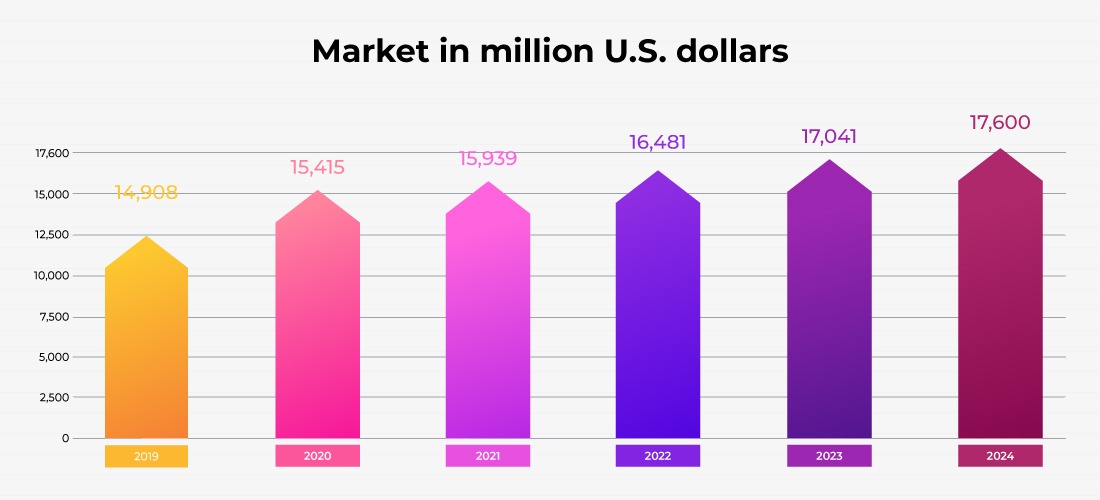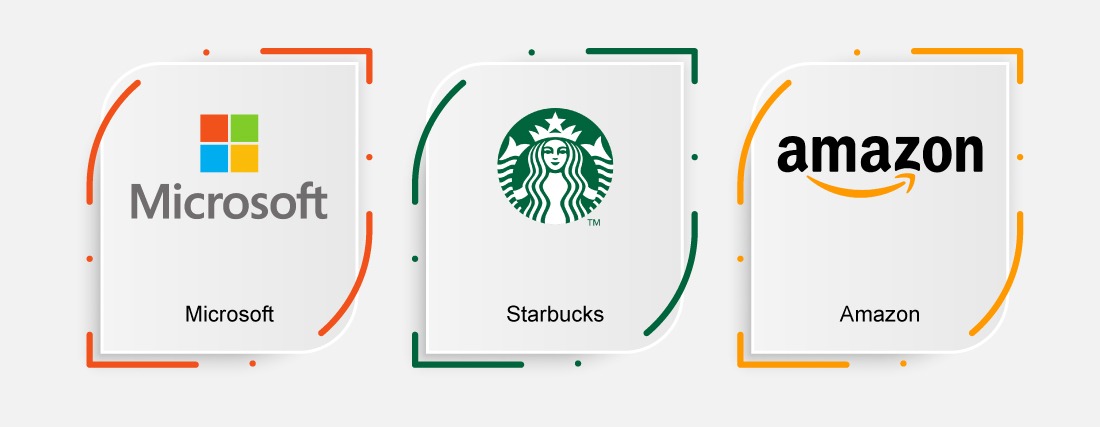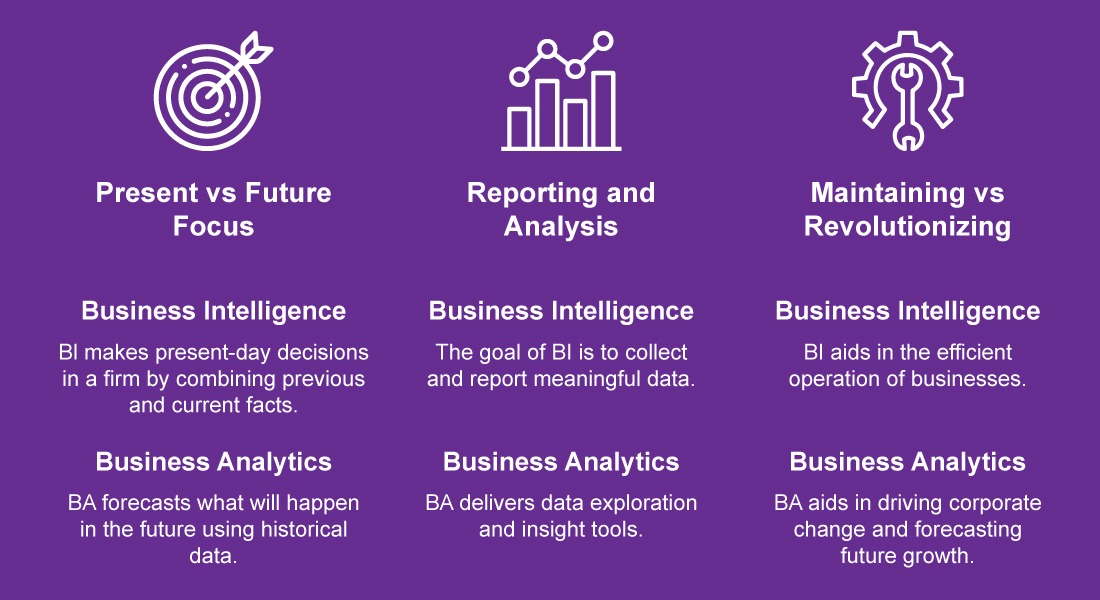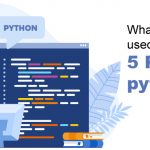Business Intelligence Vs Business Analytics: Many terms in the business world get used interchangeably. The battle has been going on for years.
In this article, we will give you a comprehensive guide to decide who wins the battle.
There’s a lot of confusion among employees, employers, and even vendors about what exactly sets these two apart from each other that allowing the argument never-ending.
The key difference between business intelligence and business analytics is the target audience and use case.
Business Intelligence refers to data-driven decision-making tools for middle managers, while business analytics helps lower-level employees make informed decisions as well.
The focus of BI remains internal, as it provides reports for decision-makers such as senior management or boards of directors.
Business Analytics has a wider scope. It focuses on improving processes, increasing efficiency, and reducing costs across various departments in an organization.
So who wins the battle? Read till the end to know more.
Here are some statistics that demonstrate the growing use of business intelligence and analytics: According to Statista,

Business intelligence and analytics software applications are predicted to grow from 14.9 billion dollars in 2019 to 17.6 billion dollars in 2024.
What Is Business Intelligence?
Business Intelligence is made up of many separate components that work together to provide insight.
While business intelligence tools process data processing and analytic data elements in reports and visualizations, the process begins with the infrastructure for receiving that data.
It requires you to link this data to the goals of your organization and be able to communicate its value to IT, business, and senior management.
Business intelligence tools access and analyze datasets and present analytic results in reports, dashboards, dashboards, charts, charts, and maps to provide users with an understanding of the state of the business.
To do this, BI analysts use current tools and datasets in the form of reports, views, tables, charts, and maps.
Thus, the main purpose of business intelligence is to answer how and what can be replicated or modified for optimal business performance.
Here are some real-world instances of how business intelligence is helping firms all across the world:

What Is Business Analytics?
Business analytics is the process of exploring data and reports to extract valuable information.
Business analytics is the study of how to utilize the big data processing power of modern IT systems.
It studies big data to store, sort, and analyze relevant data. Similar to business analysts, data scientists use data and analytics to drive innovation.
By using statistical techniques, business analysts extract useful information.
These ideas are then presented to the company’s stakeholders, who decide how to use the data.
Business Analytics uses this information to predict future customer behavior and suggests changes to a campaign or tries to simulate a specific change.
Preliminary analysis determines the likelihood of future results using data analysis tools such as machine learning and data mining.
Business intelligence can include analyzing business data, forecasting from historical data, optimizing to improve strategies, or improving data visualization with charts and tables.
The main purpose of data access and analysis is to provide essential information to improve business planning and productivity.
Here are some real-world instances of how business analytics helps firms all across the world:

Business Intelligence Vs Business Analytics – Who Wins?
Business intelligence and business analytics are equally useful for companies to understand and optimize business performance in a better and more effective way.
The battle is never-ending but both are essential and in a way complementary to one another.
While BA is more geared towards the future of business intelligence, both are important for improving business performance.
Understanding the similarities and differences between business intelligence and business intelligence can help you handle big data correctly and choose the best management software.
With the advent of big data and predictive analytics, both business intelligence and business intelligence have undergone some major changes that have made them incredibly important as data management tools.

While both data science and business analytics rely on some knowledge of data coding and manipulation, data science encompasses the more specialized areas of big data, machine learning, and artificial intelligence.
The Business Intelligence and Analytics Concentration primarily involve using data to help decision-makers make more informed decisions.
Business intelligence analysts work with data scientists to collect data, interpret patterns, and communicate how they can use the results effectively.
However, data scientists do not only focus on business-related issues but apply their skills to a wider range of fields, such as academia and technology, as well as the typical financial and business fields that business analysts may be engaged in.
Since their responsibilities also include designing, developing, and implementing algorithms for collecting and analyzing data, they tend to develop more technical skills in these areas.
Let’s see the key factors of BI vs BA
The business intelligence course is the most concerned about IT in the analysis course profession, including data storage, database management, and dashboard technology courses.
These programs may be slightly less technical than pure data analysis programs and are usually taught in business schools or vocational schools.
For example, a data analysis course may offer elective courses in areas such as machine learning (data science), strategic marketing (business analysis), and/or data warehousing (business intelligence).
Advanced databases, data warehouse technologies, and executive dashboard platforms fall under this category.
These tools provide non-technical members of the organization with access to metrics generated by data analysts.
Business intelligence uses data mining, reporting, analysis, and processing to create more effective business strategies, which directly affect business analysis in some way; but also, without BA, effective strategies cannot be formed.
For example, in addition to big data, business intelligence can also use technologies such as MicroStrategy, which essentially provides you with a very efficient and high-speed.
A dashboard that can help you track current development trends and even explore more productivity opportunities.
Finally, it’s worth noting that simple analytical applications (such as one or two tools that can be included in a complete business intelligence suite).
It can also be used to create applications that help data-driven business processes, whether it’s big data or conventional data.
Building applications involves the analytics for actually creating the required action driven by data knowledge and is highly organization-specific or even business-specific.
Therefore, business analysis has a wide range of tools that support this process, especially when the data is used for analysis.
When it comes to business intelligence, it focuses on descriptive analytics, which offers a summary of current and historical data to visualize what happened in the past and what is happening now.
We can compare business intelligence and business intelligence, for example, rearview and GPS respectively.
Where the rearview mirror shows the past with its explored data, trying to predict the future.
GPS uses predictive mechanisms such as analytical methods, statistics to identify trends, and probabilities, knowing what the future looks like – will tell you how to move forward.
To summarise the battle of Business Intelligence Vs Business Analytics ,business intelligence evaluates past and present data to effectively manage the current business.
While business analytics evaluates past data to analyze current scenarios and prepare the company for the future.
What Is The Future Of BI And BA? Final Words
It is important to understand that the analyst gains access to all his information using business intelligence.
But the transformation of this information into a useful resource is possible only through analysis because business analysis studies growth patterns, economic changes.
Further studying the market in-depth allows one to make informed decisions based on the history of the enterprise, its current functions, and its priorities.
Using data and statistics, a business analyst will solve the problems facing a company logically and analytically.
Business intelligence, on the other hand, is an umbrella term for data analysis techniques that are predictive, meaning they can tell you what will happen in the future, and prescriptive.
Which means they can tell you what you should do to achieve better results.
However instead of business intelligence vs business analytics, if you make it business intelligence and business analytics, they can become your wherewithal.
Organizations typically use modern business intelligence tools.
When business users need information about rapidly changing dynamics, such as marketing efforts, where speed is important rather than getting 100% correct data.
While predictions and recommendations derived from business analytics require analysis and interpretation by data scientists.
One of the goals of business analytics is to make it easy for non-technical end-users to understand and even dive into the data and create new reports.
So in this battle of business intelligence vs business analytics, you can win if you get expert guidance on how to apply both of them simultaneously.
Want expert guidance? Feel free to reach out today!
Read More: WHY IS BUSINESS INTELLIGENCE IMPORTANT? ALL YOU NEED TO
























